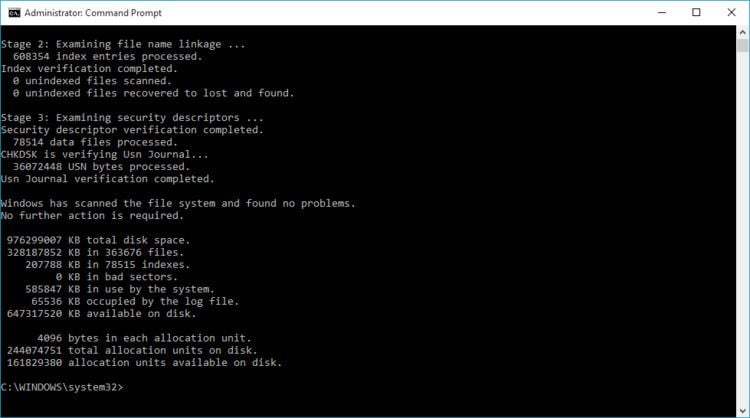Type Utility software | ||
 | ||
CHKDSK (short for "check disk") is a system tool in DOS, OS/2 and Windows. It verifies the file system integrity of a volume and fixes logical file system errors. It is similar to the fsck command in Unix.
Contents
On Windows NT operating systems, CHKDSK can also check the disk surface for bad sectors and mark them. (In MS-DOS 6.x and Windows 9x, this is a task done by Microsoft ScanDisk.) Windows Server version of CHKDSK is RAID-aware and can fully recover data in bad sectors of a disk in a RAID-1 or RAID-5 array if other disks in the set are intact.
CHKDSK can be run from DOS prompt, Windows Explorer, Windows Command Prompt or Recovery Console.
Overview
On Windows NT family, a standard CHKDSK scan consists of three phases of testing file metadata. It looks for errors but does not fix them unless it is explicitly ordered to do so. Same applies to surface scan: This test, which could be extremely time-consuming on large or low-performance disks, is not carried out unless explicitly requested. CHKDSK requires exclusive write access to the volume to perform repairs.
Because of the exclusive access requirement and the time-consuming nature of CHKDSK operation, Windows Vista implemented a new file system health model in which the operating system fixes errors on the volumes as it encounters them. In the event that the problem is grave and a full scan is required, Action Center notifies the user to take the volume offline at the first convenience.
Windows Vista and Windows Server 2008 added self-healing ability, turned on by default, in addition to providing the CHKDSK command. It detects physical file system errors and silently fixes them on the fly. Thus, many problems previously discovered on running CHKDSK never appear. It is administered by fsutil repair command.
The MS-DOS 5 Bug
CHKDSK and UNDELETE in MS-DOS 5.0 have a bug which can corrupt data: If the file allocation table of a disk uses 256 sectors, running CHKDSK /F can cause data loss and running UNDELETE can cause unpredictable results. This normally affects disks with a capacity of approximately a multiple of 128 MB. This applies to CHKDSK.EXE and UNDELETE.EXE bearing April 9, 1991 datestamp. This bug was fixed in MS-DOS 5.0a.
The alleged Windows 7 Bug
Before the release of Windows 7, InfoWorld reported an alleged memory leak in CHKDSK; according to the report, the chkdsk /r command would cause the memory consumption to reach the maximum and the system to crash. Randall C. Kennedy of InfoWorld attributed the original report to "various Web sources" and said that in his tests, the memory consumption reached above 90%, although he did not experience a crash. Nevertheless, Kennedy took the memory consumption for a critical bug that would derail Windows 7's launch and cynically chastised Microsoft. Tom Warren of Neowin dismissed Kennedy's assessment of the alleged leak's significance. Steven Sinofsky of Microsoft also responded that Microsoft could not reproduce a crash either but that the massive memory consumption was by design, to improve performance, and not a leak. Ed Bott of ZDNet also reviewed the claim with his own tests and observed that no crash would occur. Noting that chkdsk /r, by design, does not work on the system drive while Windows is online, Bott concluded "it’s arguably a feature, not a bug, and the likelihood that you’ll ever crash a system this way is very, very small and completely avoidable."
